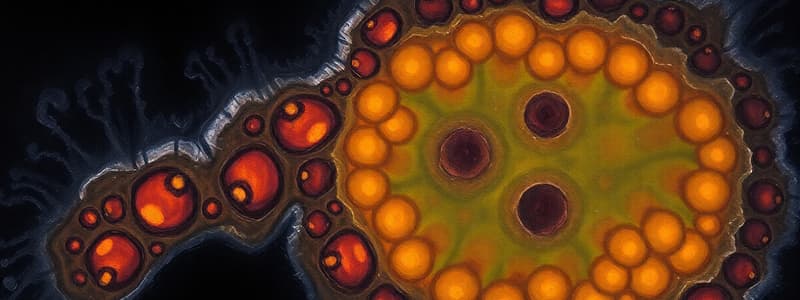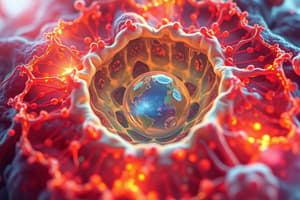Podcast
Questions and Answers
What organelle is known as the powerhouse of the cell?
What organelle is known as the powerhouse of the cell?
- Nucleus
- Ribosome
- Mitochondria (correct)
- Golgi apparatus
The primary function of lysosomes is to facilitate movement.
The primary function of lysosomes is to facilitate movement.
False (B)
What type of connective tissue primarily composes bones?
What type of connective tissue primarily composes bones?
collagen
The __________ connects muscles to bones.
The __________ connects muscles to bones.
Match the organelle to its function:
Match the organelle to its function:
Which component of the skeletal system is flexible and cushions bones?
Which component of the skeletal system is flexible and cushions bones?
Red bone marrow is responsible for storing fat.
Red bone marrow is responsible for storing fat.
What is the role of the endoplasmic reticulum in a cell?
What is the role of the endoplasmic reticulum in a cell?
Flashcards
Cell Membrane
Cell Membrane
A thin, selectively permeable barrier that surrounds the cell, controlling what enters and exits.
Cytoplasm
Cytoplasm
The gel-like substance that fills the cell, containing organelles and providing a medium for chemical reactions.
Nucleus
Nucleus
The control center of the cell, housing DNA and directing cellular activities.
Mitochondria
Mitochondria
Organelles responsible for generating energy (ATP) through cellular respiration.
Signup and view all the flashcards
Skeletal System
Skeletal System
A framework of bones that supports the body, protects internal organs, and allows for movement.
Signup and view all the flashcards
Compact Bone
Compact Bone
Dense, strong bone tissue forming the outer layer of bones.
Signup and view all the flashcards
Spongy Bone
Spongy Bone
Porous, lightweight bone tissue found inside bones.
Signup and view all the flashcards
Joints
Joints
Locations where two or more bones meet, allowing for movement.
Signup and view all the flashcardsStudy Notes
Cell Structure and Function
- Cells are the basic units of life, exhibiting a complex internal organization.
- The cell membrane is a selectively permeable barrier, regulating what enters and exits the cell.
- The cytoplasm is the gel-like substance filling the cell, containing organelles.
- The nucleus houses the genetic material (DNA), crucial for cell function and reproduction.
- Mitochondria are the powerhouses of the cell, generating energy (ATP) through cellular respiration.
- Ribosomes are responsible for protein synthesis.
- Endoplasmic reticulum (ER) is a network of membranes involved in protein and lipid synthesis.
- Golgi apparatus modifies, sorts, and packages proteins for secretion.
- Lysosomes contain enzymes that break down cellular waste and debris.
- Vacuoles are storage sacs for water, nutrients, and other substances.
- Centrioles play a role in cell division.
- Different cell types have specialized structures for their specific functions.
Skeletal System Overview
- The skeletal system provides support, protection, and allows for movement.
- Bones form a rigid framework that supports the body and provides attachment points for muscles.
- The skeletal system protects internal organs, such as the brain, heart, and lungs.
- Bones facilitate movement through joints and skeletal muscle interaction.
- The skeleton plays a vital role in blood cell production within bone marrow.
- Bones store minerals, such as calcium and phosphorus, which are essential for various bodily functions.
Skeletal System Components
- Bones are composed of specialized connective tissue, primarily collagen and minerals.
- Compact bone is dense and strong, providing a hard outer layer.
- Spongy bone is porous and lightweight, found within the interior of bones.
- Cartilage is a flexible connective tissue, forming joints and cushioning bones.
- Joints are where two or more bones meet, allowing for movement.
- Different types of joints (e.g., hinge, ball-and-socket) allow for various ranges of motion.
- Ligaments connect bones to bones, providing stability to joints.
- Tendons connect muscles to bones, facilitating movement.
- Bone marrow is found within the medullary cavity of bones.
- Red bone marrow produces red blood cells and some white blood cells.
- Yellow bone marrow primarily stores fat.
Studying That Suits You
Use AI to generate personalized quizzes and flashcards to suit your learning preferences.




